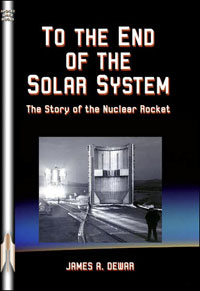Review: To the End of the Solar Systemby Jeff Foust
|
| In the book’s final chapter Dewar clearly becomes a champion of the nuclear rocket, and sees the work on it as central to the development of the space program in the 1960s, not a forgotten sideline. |
Dewar does a good job balancing the technology of nuclear rocketry with the political issues associated with it. The book alternates between recounting the progress made in tests of nuclear engines at the Nevada Test Site and the political machinations involved with the program in Washington. Dewar is equally comfortable delving into the design of various engines as he is recounting the behind-the-scenes political maneuvering involved with funding and running the project. Given how intertwined technology and policy are in efforts like this, being proficient in both areas is essential.
One flaw in To the End of the Solar System, though, is an overzealous boosterism for nuclear propulsion that emerges near the end of the book. In much of the book it’s clear that Dewar (whose exceedingly brief bio in the back of the book describes him only as someone who “worked exclusively on nuclear affairs” at the Department of Energy and predecessor offices) is sympathetic to the effort to develop nuclear engines for spaceflight. In the book’s final chapter (before a series of appendices and detailed references), though, he clearly becomes a champion of the nuclear rocket, and sees the work on it as central to the development of the space program in the 1960s, not a forgotten sideline. He even goes so far as to claim that “the nuclear and space programs have been the primary drivers of the U.S. economy since World War II” and that the investment into NERVA was a “mini-fulcrum” that yielded benefits that far exceeded the $1.4 billion in then-year dollars spent on it. While Dewar attempts to justify the latter by noting the technologies spun off from NERVA research (including, ironically, advances in cryogenics that benefited chemical rocket propulsion), he makes no attempt to quantify the former claim.
Dewar argues near the end of To the End of the Solar System that interest in nuclear rockets has increased since NERVA’s cancellation in the early 1970s. That interest, though, even if true, has not translated into increased funding for such work. (Dewar briefly mentions Project Prometheus, a NASA effort to develop nuclear power and propulsion announced in 2003, but writes that he doesn’t discuss it in detail because “NASA was still defining the details when this book was in the final stages of the publication process”; a curious statement for a book with a 2007 copyright date, by which time Prometheus had effectively died.) While nuclear propulsion might have great technical advantages over chemical propulsion, its proponents have yet to make the case that it is so essential that it is worth the considerable investment needed for such systems‒not to mention the inevitable opposition from some quarters to anything with the word “nuclear” attached to it. Thus, it may well be a long time before we see the resumption of technology development efforts like those chronicled in To the End of the Solar System.
